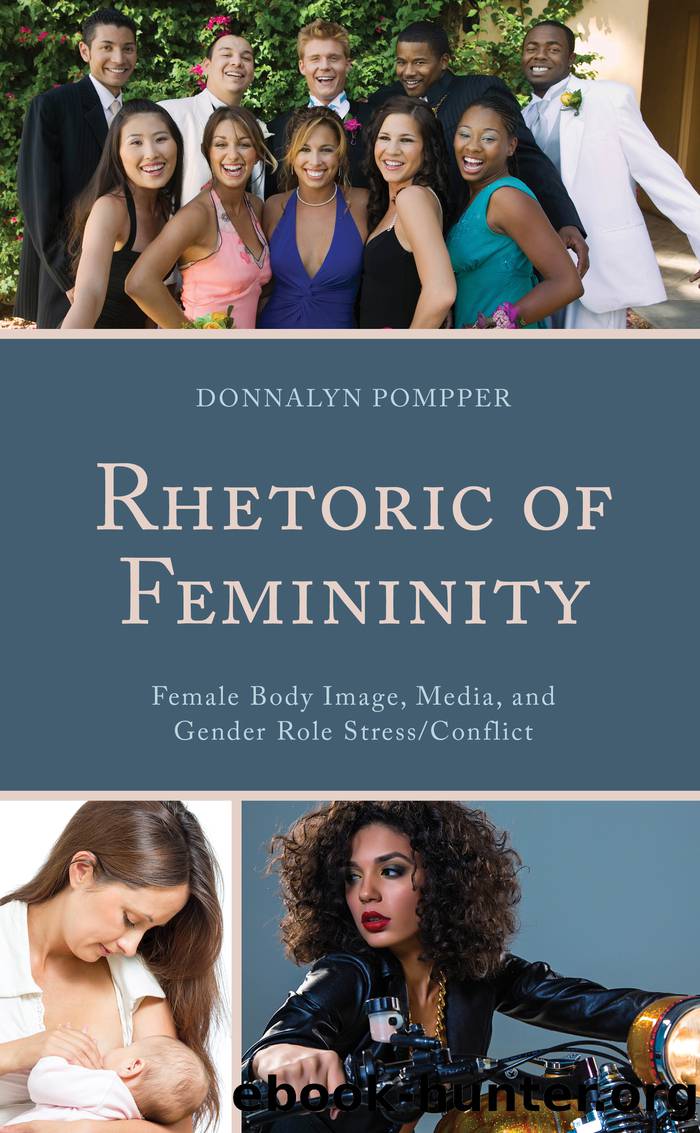Rhetoric of Femininity by Pompper Donnalyn;

Author:Pompper, Donnalyn;
Language: eng
Format: epub
Tags: undefined
Publisher: Lexington Books/Fortress Academic
Published: 2012-09-15T00:00:00+00:00
Sports Illustrated began publicizing photographs of female athletes as swimsuit models in 1997 and the first female athletes to appear were bikini-clad members of the U.S. beach volleyball team. A comparison of athletes versus fashion models in Sports Illustrated swimsuit issues revealed few differences between groups since all women were positioned in ways that emphasized femininity rather than athleticism, and sexually objectified women, collectively perpetuating female gender stereotypes (Kim & Sagas, 2014). In fact, sexualized images of female models in the sports industry have increased in popularity over time (Daniels & Wartena, 2011), and Sports Illustrated also features NFL cheerleaders, NBA dancers, and wives or girlfriends of male athletes as swimsuit models.
Undeniably, women are treated differently in the world of sports media; sexualized as objects and marginalized in the newsroom and as news audiences. Sports journalists have developed a hierarchy of most- and least- feminine sports for women, or gender marking, which paradoxically facilitates sexploitation and infantilization of female athletes as nonthreatening girls. Print and television sports journalists do not consider women who play sports as real athletes (Trolan, 2013, italics added). Instead, journalists engage with sport typing so that individual, non-contact sports like figure skating, gymnastics, and tennis effectually maintain normative emphasized femininity standards and receive greater media coverage than team sport events perceived as masculine (Hardin & Greer, 2009) which may have âless glamorousâ female athletes (Trolan, 2013, p. 219). Media consistently emphasize female athletesâ femininity, heterosexuality, and heterosexual appeal over their athletic performance (Kane & Maxwell, 2011). Furthermore, lesser coverage of womenâs sports as compared to menâs sports continues and television coverage is lower than ever with just 1.6 percent of sports airtime devoted to womenâs sports (Cooky, Messner, & Hextrum, 2013). Effects of these negative trends suggest lowered expectations for and perceptions of womenâs athletic ability, and negative body image among girls (Daniels, 2009). Findings of a study of global newspaper coverage of the Olympic Games suggested that sexualization may be contextual, with New Zealand, Japan, South Korea, and Turkey reporting that it is primarily athletes from outside the home nation who are sexualized (Bruce, Hovden, & Markula, 2010).
Female sports journalists experience their own fragmented professional identity and gender role stress/conflict when it comes to femininity. Men âown sports journalism because they own sportsâ (Hardin & Shain, 2006, pp. 335â36). On the one hand, female journalists are expected to conform to a social definition of femininity, while also adapting to professionalism standards developed by men. Feminine values of nurturing, kindness, and compassion conflict with the detached, tough journalistâs manner (van Zoonen, 1994) and set female journalists up to fall into a âfriendliness trapâ when their open-communication skills may get them in the door, but then work against them when they seek career growth opportunities (Frohlich, 2004, p. 67). On the whole, female sports journalists can reconcile the contradictions but never may be wholly accepted as equals with men in sports newsrooms (Hardin & Shain, 2006).
Download
This site does not store any files on its server. We only index and link to content provided by other sites. Please contact the content providers to delete copyright contents if any and email us, we'll remove relevant links or contents immediately.
Cecilia; Or, Memoirs of an Heiress — Volume 1 by Fanny Burney(32175)
Cecilia; Or, Memoirs of an Heiress — Volume 3 by Fanny Burney(31568)
Cecilia; Or, Memoirs of an Heiress — Volume 2 by Fanny Burney(31524)
The Lost Art of Listening by Michael P. Nichols(7264)
Asking the Right Questions: A Guide to Critical Thinking by M. Neil Browne & Stuart M. Keeley(5470)
We Need to Talk by Celeste Headlee(5438)
On Writing A Memoir of the Craft by Stephen King(4730)
Dialogue by Robert McKee(4212)
Pre-Suasion: A Revolutionary Way to Influence and Persuade by Robert Cialdini(4026)
I Have Something to Say: Mastering the Art of Public Speaking in an Age of Disconnection by John Bowe(3794)
Elements of Style 2017 by Richard De A'Morelli(3255)
The Book of Human Emotions by Tiffany Watt Smith(3169)
Fluent Forever: How to Learn Any Language Fast and Never Forget It by Gabriel Wyner(2943)
Name Book, The: Over 10,000 Names--Their Meanings, Origins, and Spiritual Significance by Astoria Dorothy(2877)
Good Humor, Bad Taste: A Sociology of the Joke by Kuipers Giselinde(2835)
Why I Write by George Orwell(2804)
The Grammaring Guide to English Grammar with Exercises by Péter Simon(2657)
The Art Of Deception by Kevin Mitnick(2638)
Ancient Worlds by Michael Scott(2533)
